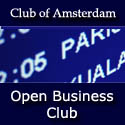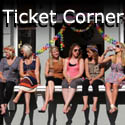Welcome
to our bi-weekly ![]() Club
of Amsterdam Journal.
Club
of Amsterdam Journal.
"We all have every right to a successful life, happy life,"
His Holiness the 14th Dalai Lama said, emphasizing that money shouldn't
be part of the definition of success or happiness. "We should not
forget our inner values. By inner value I mean ... human affection,
or another word, human compassion."
Felix
Bopp, editor-in-chief
Join
our next Season Event about ![]() the
future of Success on April 26.:
the
future of Success on April 26.:
And check out our
lab in Girona near Barcelona:
![]() LAB
on
MEDIA and
Human Experience
- May 29&30
LAB
on
MEDIA and
Human Experience
- May 29&30

| .Aspects of Mobility | ||

|
By Arnab B. Chowdhury Arnab B. Chowdhury is founder and CEO of Ninad (www.ninad.biz) – an international e-Learning consulting firm, headquartered at Pondichéry, South India. |
|
|
The answer perhaps lies in that basic instinct called - mobility.Over the past two hundred odd years, the fundamental pattern of human mobility has changed. Physical mobility has begun to be superseded by logical mobility that relates more towards our emotional and intellectual needs rather than solely our physical wants. For millennia, we have been physically mobile whether in the form of individual, family, tribe or army moving in search of better sustenance - better arable land, water, wealth, power or simply aspiring for better quality of life. Logical mobility was founded more recently in 1830 when Joseph Henry demonstrated the potential of using electromagnetic phenomenon of electricity for long distance communication by sending an electronic current over one mile of wire to activate an electromagnet which caused a bell to ring. Later in 1844, Samuel F. B. Morse used this property of electricity to invent the telegraph and transmitted his famous message "What hath God wrought?" from Washington to Baltimore – a distance of 40 miles. Then followed, the epoch making first voice call over wire -- "Mr. Watson, come here, I want you!” by Alexander Graham Bell in 1876. Logical mobility evolved from ringing a bell to telegraph to telephone, which in turn led to the television. Later, in 1957 in retaliation to the launching of Sputnik – the first artificial satellite by the USSR, the United States formed the Advanced Research Projects Agency (ARPA) within the Department of Defence. The mandate for Paul Baran of RAND corporation was to maintain its command and control over its missiles and bombers with a decentralized communication network in case of a Soviet nuclear attack. His final proposal was a packet switched network wherein packets of data (datagrams) were labelled to indicate the origin and destination of the information to be sent to the destination computer in the network. Multiple flavours of packet-switched networks including TCP/IP and X.25 emerged. TCP/IP, driven by education and defence in the United States, grew as a data network for computer users community - while the European industry nurtured X.25 that grew as the network offered by the telecom operators. Add to it the development of the World Wide Web (WWW) started by Tim Berners-Lee as a text processing software in European Particle Physics Laboratory in Switzerland back in 1989. This phenomenon converged communication technology with information technology, which ushered in the digital economy. With the World Wide Web, three societal needs were given the appropriate media platform to nurture: communication, commerce and entertainment. In all, this convergent development met the basic aspiration of logical mobility – the need and ability to access data, information and knowledge from anywhere, anytime. But is logical mobility really making a difference to the quality of human life from a socio-economic perspective? The answer is 'yes' among the digital divide 'haves'. We, as distant learning student, sales professional, retail investor, digital entertainment consumer or anybody labelled as mobile worker, are already leveraging upon near-instant wireless and wireline information on the fly with networked devices such as cell phones, PDAs (Personal Digital Assistant) and a host of smart mobile devices like the iPod. But what about the 'have-nots'? What about that eighty percent of the global population that lives on less than one dollar a day, most of whom -- according to the World Resources Institute -- have never made a telephone call, let alone used the Internet? The answer is an almost inaudible 'yes' with a booming 'no'. We still have to imagine how the benefits of mobile computing can percolate down to the larger bottom-tier of humankind when much larger issues such as health, literacy, and economic sustenance-related issues are looming ahead. A total sceptic might snigger – hey if we cannot supply decent electricity can we have PCs or cell phones that don't use electricity instead? Or look at the Dot Com boom and bust wherein we simply ignorantly labelled the 'have-nots' as 'have-laters'? However, the optimist in us says that all is not lost. We aren't talking about the Wi-Fi hotspots and satellite telephones in the digital 'haves' world but about a couple of pioneering instances closer home in the Indian subcontinent where the digital economy landscape is as diverse from the hi-tech hub of Bangalore to Balasore district and where logical mobility has changed the lives from 'have-nots' to 'haves-now'. One shining example is the Village Phone Program by GrameenPhone in cooperation with Grameen Bank – Bangladesh's internationally renowned micro-credit lending institution. This Program is a unique effort that provides telecommunications facilities in rural areas while providing the Village Phone operators, mostly poor rural women, a good earning opportunity with the commitment of "good development is good business". As an owner-operated pay phone, the Village Phone Program provides telephone services in rural areas where no such facilities existed before. It allows the rural poor, who cannot afford to become a regular subscriber, to avail the service. Typically, a borrower of Grameen Bank takes a loan of around 12,000 Taka and buys a handset and subscription of the mobile service while she is also trained on to how to operate it and how to charge the users for it. As of October 2003, there were more than 39,000 Village Phones in operation operating in nearly 28,000 villages of some 58 districts encompassing more than 50 million people living in remote rural areas! Technologically, High Gain Antenna ensures smooth call completion in areas of weak signal while extending coverage for the Village Phone operation without further investment in network expansion. To counter remote villages without electricity, solar panel and DC batteries are being used for charging the cell phones. As a business, the average revenue per user (ARPU) of Village Phone subscribers is double that of the average business user. So imagine the difference in quality of life this Program can create in terms of being an essential communication channel during relief operations in the context of natural disasters, and in future when GrameenPhone integrates content services such as distance education, health assistance and adult education via fax, e-mail and Internet. Another potential case is a project called 'Open Source Simple Computer for Agriculture in Rural Areas' or OSCAR that has the objective of developing a decision-making tool for weed identification and control that will address the issue of the declining agricultural productivity in South Asia. And that decision-making tool is essentially logically moulding agronomy know-how software onto a 'Simputer' - a hand-held 32MB Linux-based computer using smartcard technology that runs on three AAA batteries with a price tag of about Rs.10,000. Imagine Baldev Singh, a wheat farmer, instead of relying on his Doordarshan-fed Krishidarshan capsule, checking out his crop to evaluate his quality of wheat output with an easy-to-interface species identification software program in Hindi! A joint effort by French Institute of Pondicherry, Rice Wheat Consortium for the Indo-Gangetic Plains (Delhi), University of Wageningen (the Netherlands), and Centre de Coopération Internationale en Recherche Agronomique pour le Développement (CIRAD–France), OSCAR has the potential to make a difference to the quality of agro-output, mindset and finally the quality of life for the millions of farmers and in turn millions of consumers in the Indo-Gangetic Plains and beyond. With the digital economy, a new mobility paradigm has evolved from a physical mobility of goods (atoms and molecules) to logical objects (bits). Actual information and business workflows have changed in terms of operations leveraging upon the four essential characteristics of the digital economy – digitisation, immediacy, globalisation and virtualisation. Economic divide in the society-at-large between the rich and the poor has always been an age-old issue that thinkers, philosophers and politicians have been trying to bridge with severe lack of success. In the digital context, the economic divide continues to lie in the ability to find, create, develop and utilize the right information at the right time in a cost-effective manner. Is logical mobility as a phenomenon going to help us to bridge that divide or is it going to be a grand global case of technological apartheid? |
||
| .News about the future of Success | ||
 |
|
|
 |
In fact, studies show that these personality traits —optimism and pessimism — can affect how well you live and even how long you live. Need an attitude adjustment? Find out how to reduce your stress by halting negative thoughts and practicing positive self-talk. Be positive: Live
longer, live healthier Some of your self-talk comes from logic and reason. Other self-talk may arise from misconceptions that you create because of lack of information. |
|
| .Club of Amsterdam blog | ||
 |
April
20: |
|
| .News about the Future | ||
 |
|
|
 |
The US Commerce Department is seeking public input on ways to measure innovation in the economy. "Input from innovators, entrepreneurs from businesses of all sizes, and academics is very important to the Committee as it develops ideas for innovation metrics," Gutierrez said. "Innovation is a driver of our economy and we need to help policymakers and the business community better measure innovation for the purpose of developing appropriate public policy." The Committee anticipates the recommendations will cover the following four major categories identified by the participants during the initial meeting:1. Improvement of the underlying architecture of the U.S. System of National Accounts to facilitate development of improved and more granular measures of innovation and productivity; 2. Identification of appropriate economy-wide and sector-specific statistical series or other indicators that could be used to quantify innovation and/or its impacts; 3. Identification of firm-specific data items that could enable comparisons and aggregation; and 4. Identification of specific "holes" in the current data collection system that limit our ability to measure innovation. |
|
| .CitySense | ||
|
|
||
 |
A CitySense node gathers weather data on the rooftop of BBN Technologies Inc. | |
"An open test bed lets people reprogram the network to run their own experiments," Matt Welsh said, head of the project and assistant professor of computer science at Harvard University. Each node contains a tiny computer that can upload programs. "Researchers can then have access remotely over the Internet," he said. |
||
 |
||
| .Next Season Event | ||

|
Thursday, April 26, 2007 Registration: 18:30-19:00, Conference: 19:00-21:15 Where: Info.nl, Sint Antoniesbreestraat 16, 1011 HB Amsterdam [Next to Nieuwmarkt] With Nisandeh Neta, Founder, Open Circles Academy: Beyond Success Huib Wursten, Managing Partner, ITIM International: The Meaning of Success in Different Cultures Moderated by Homme Heida, Promedia, Member of the Club of Amsterdam Round 


Supporter  |
|
| .Recommended Book | ||
 |
by Nisandeh Neta This book reveals the ingredients that make up every successful result. It offers a five-step process of creating success, with in-depth explanations on each step and tips how to work with them. It teaches you how to manage every step of the way to your personal success, with little effort and maximum results. Often we are not aware
of what the elements are of the process of creation. Once we're
good at something, we think it is because of our talent, or because
of being lucky, without investigating what the process was that
moved us from the state of "hunger" to the state of "fulfilment".
The book "Elements of Success" teaches you all you need to know about the recipe for success. Becoming successful is easy, if you know what to do... |
|
| .First Deep-Sea Observatory | ||
|
Providing electrical
power and data connections for new research instruments in the deep-sea.
That's the vision behind the
|
||
 |
||
| .Media LAB | ||
|
||
| .From water into wine into ... dresses? | ||
|
A biologist and artist make clothing out of the slimy films from wine contaminated with bacteria We're looking at [the dresses] to provoke some discussion about future fashions, about the possibility of other material we can use instead of our normal cottons and silks," says Gary Cass, who works on the |
||
|
Micro'be'
Seamless Wear investigates the practical and cultural biosynthesis
of clothing
- to explore the possible forms and cultural implications of futuristic dress-making and textile technologies. Instead of inanimate weaving machines producing the textile, living microbes will ferment a garment. A grown seamless garment will not only rupture the meaning of traditional interactions with body and clothing; but also raise questions around the contentious nature of the living materials themselves. grown seamless garment will not only rupture the meaning of traditional interactions with body and clothing; but will also raise questions around the contentious nature of the living materials themselves. This project redefines the production of woven materials. |
||
 |
Fermented fashion, cavewoman style. The dress is made from fermented red wine and must be kept wet otherwise it tears (Images: Micro'be' project) | |
 . .

|
||
| .Agenda | ||
|
||
|
||
|
||
| .Club of Amsterdam Open Business Club | ||

|
Are you interested in networking, sharing visions, ideas about your future, the future of your industry, society, discussing issues, which are relevant for yourself as well as for the 'global' community? The future starts now - join our online platform ...: http://www.openbc.com/go/invuid/Felix_Bopp2 CIWI - Creative Minds Worldwide |
|
| .Contact | ||
|
||
| .Subscribe & Unsubscribe | ||
|
||
| m | ||
Copyright © 2002-2007, Club of Amsterdam. All rights reserved.












